It may be a small world after all. Luke Smithwick makes a go of it in the Karakoram and Himalaya.
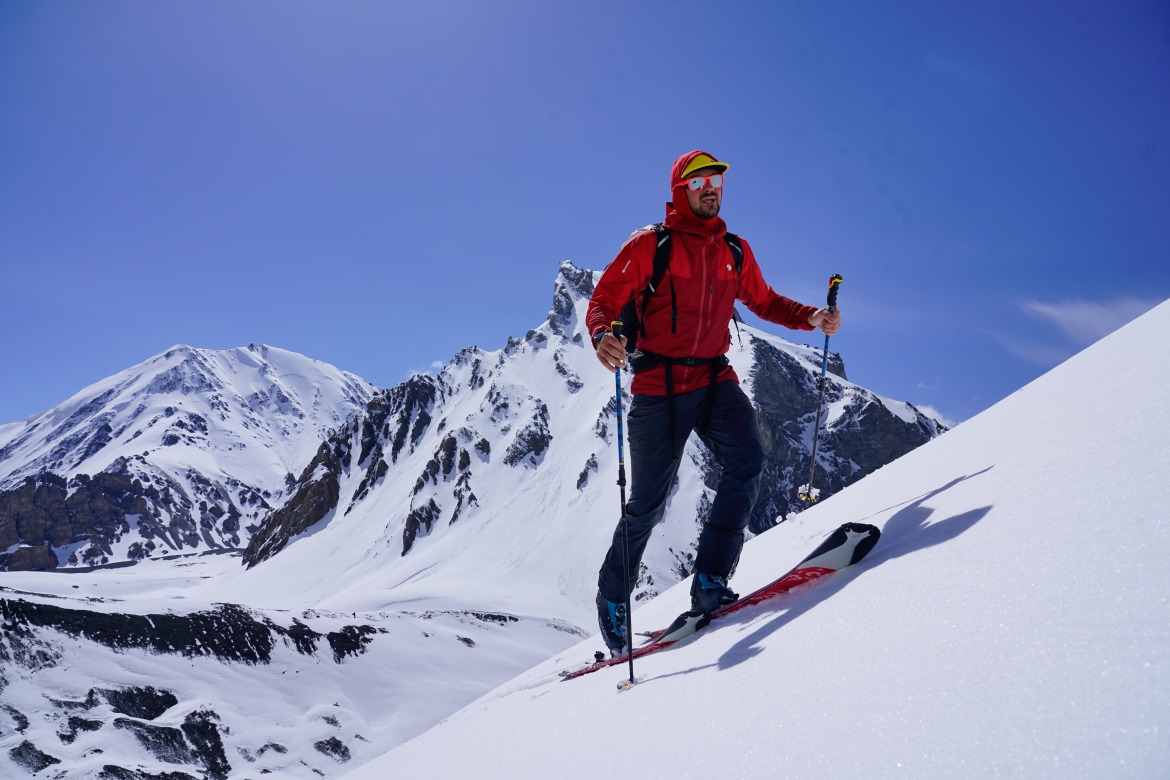
Smithwick touring for a ski line at 17,000 feet in the Shimshal region of the Pakistan Karakoram. May-July is the steeper skiing season for the Himalaya and Karakoram at the 15,000 – 20,000 foot elevation. To catch ski lines on the bigger peaks at the 20,000-29,000 foot elevation, late August into early October is the season, after the monsoon snows have deposited snow throughout the Summer.
Shallow as it may be, what caught my attention first was the Siberian Husky, Wolfie, romping around near the Tetons with Himalayan guide, skier, and climber Luke Smithwick. The dog’s IG account was the proverbial tip of the iceberg. As a dreamer of places I’d like to be, but most often content locally, Smithwick caught my attention with his pivot to the Karakoram and Himalaya to carve out a guiding career and pursue personal ski objectives.
The interview with Smithwick below stems from a call last month and an email exchange in late June. The interview has been lightly edited. Photos courtesy Luke Smithwick.
WildSnow: How do you make a go of it as a guide and pursue your own goals as a climber and ski mountaineer? How do you make a go of it being in Asia for a large chunk of the year?
Luke Smithwick: I try to pursue work that speaks to me. You know, I’ve done it for so long. I’ve never been to the south side of Everest. I’ve never been to Ama Dablam. I don’t really know many people that do work there as guides, just because I’m choosing areas that a lot of times the mountains don’t even have names, or they have this random photo or something scribbled on the back of a napkin from a talk at a pub or something. And I’ll just figure it out. That’s what I’m focused on.
And I think people pick up on what I may have to offer and what interests me, you know, people who’ve climbed Everest or maybe they’ve done a lot all over the world and are looking for something new. That’s usually who joins me on trips when I’m guiding, people who’ve already have a ton of experience. And I’ve never repeated a trip. I don’t go back to the same mountain. It’s different every time, so it’s this focus on quote, unquote, “exploration” in these valleys. I’m approaching it like this: people have been living there for centuries and millennia as pastoral farmers. I’m simply starting to look at it through the lens of skiing or climbing, or mountaineering. Not many people have been to some of these places, so for me, it’s interesting on many levels.
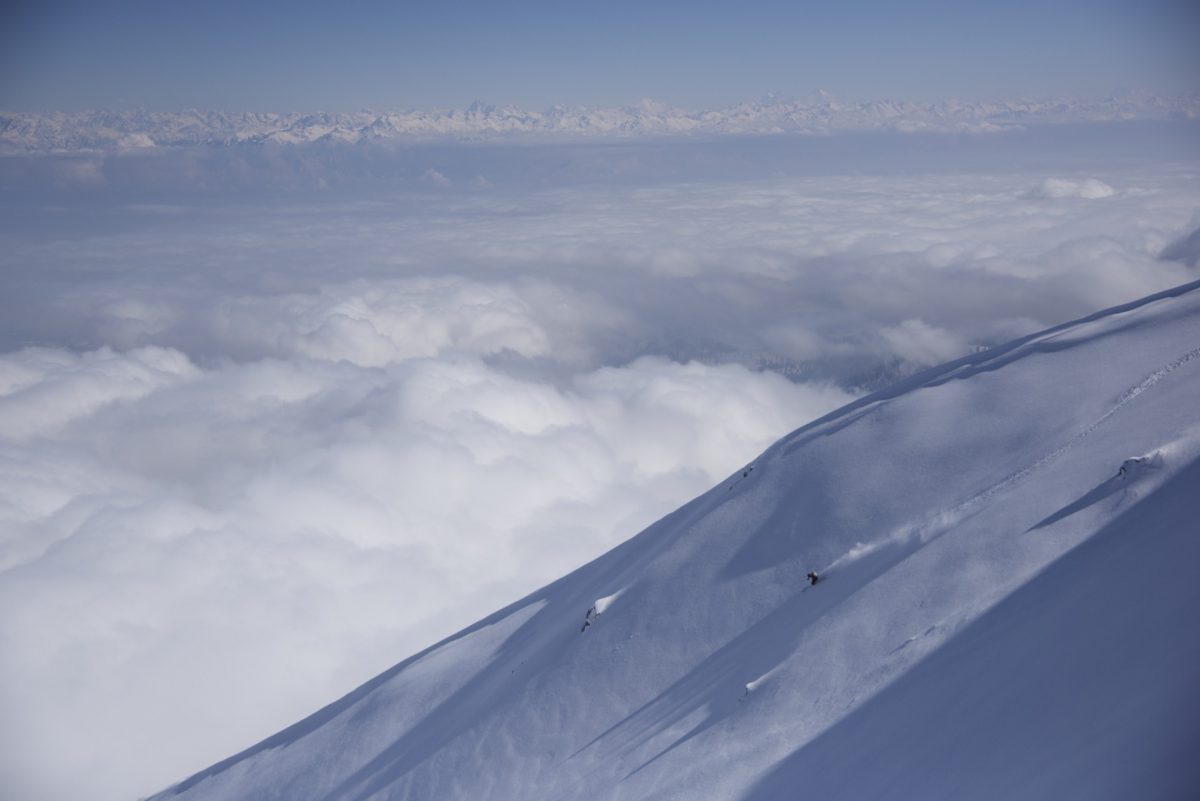
When the large storm cycles clear in the Kashmir Himalaya, you get to tour up into the high Alpine. In this image you can see the Great Himalaya range to the East on the horizon, including 23,000 foot Nun (pronounced: Noon) and Kun. Just to the North (out of the picture) on the horizon is K2 and Nanga Parbat, two iconic ski mountaineering objectives. Smithwick skiing an Alpine bowl is district Baramulla, Kashmir. This is Kashmir, February is the month. The Himalaya have it all for skiing.
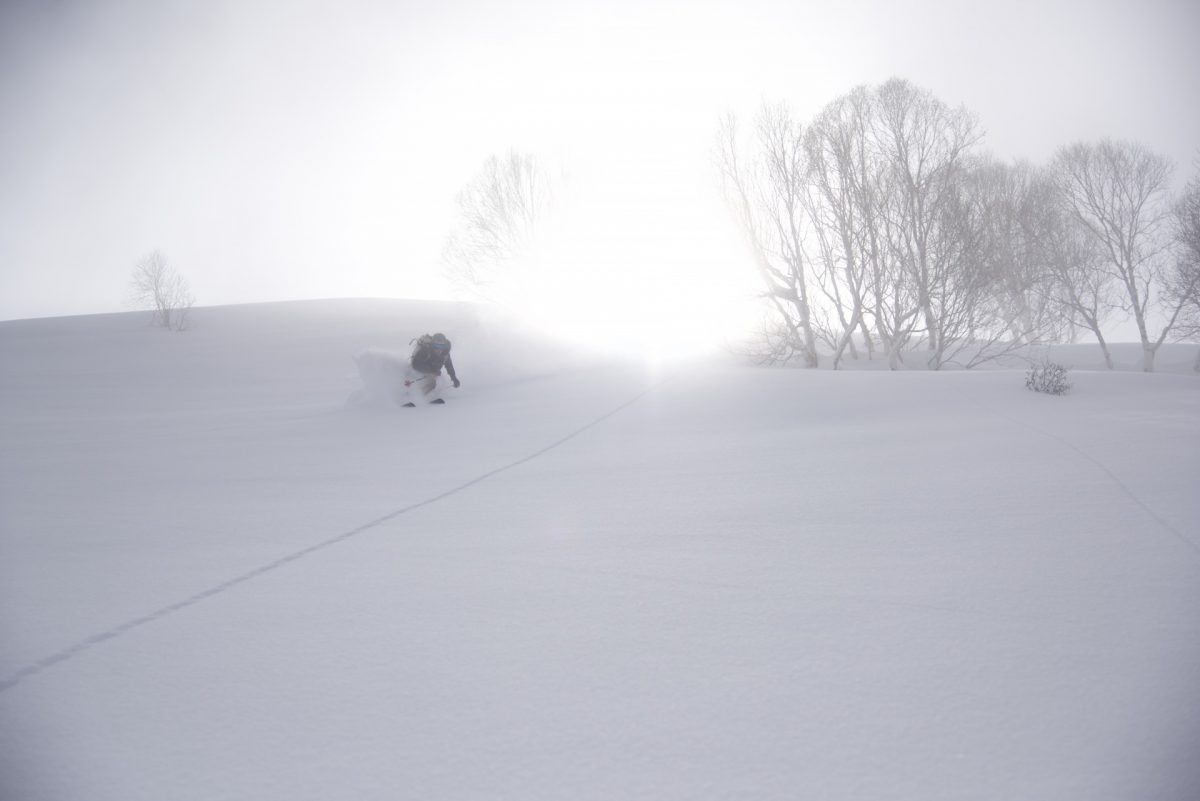
The North facing birch trees of the subalpine ecotone hold great snow for weeks after storms in Kashmir. Smithwick here catching early morning light with cold snow conditions, storms generally stack up back to back in Kashmir during February and March, however if there is a longer dry period, the North facing trees always hold sheltered (untracked of course) powder skiing.
WS: Who’s finding you? And you noted that most of your clients are from Europe and Asia. Are they finding you through word of mouth? Or is that primarily how they’re reaching out to you?
LS: It’s most often word of mouth. And it’s also just random Google searches for alpine style or various things online. But a lot of it is word of mouth. And it’s small; I have the same people come back every year or every other year. That’s because I offer something different from what everyone else is doing regarding how you imagine a packaged tour. It’s out there , it really is. It’s out there for me.
We’re figuring it all out every day, and we don’t necessarily know the spot for our base camp. Often we are basing info on a Google Earth image, and the Google Earth imagery does not possess a ton of detail because there’s no bustling economy. There’s no reason to have a detailed image in a mountain valley way off the beaten track. It’s like that talus field could be a scree field or a boulder field. You don’t really know what you’re going to find out there.
The terrain you are speaking about is relatively unexplored from a skiing standpoint, so maybe there is terrain or a zone where you could get skunked. But, still, you’re going to have a freaking cool adventure. Is that sort of a known unknown for your clients? It’s like, look, there’ll be snow, but we don’t know what the outcome will be. Is that kind of like how you package this?
I wouldn’t say it’s in terms of getting skunked. I think you can get stung. In terms of guiding, people ask how many ski days we’re going to get and how much vert will we get each day, right? Those are funny questions about what I’m doing. If those questions come up, I usually redirect the conversation. But really, the people who reach out for these trips, the off-the-beaten-track, and the Himalaya trips, usually they have done it all. They’ve been to Japan, skied all the powder, and are looking for the next thing. So when they ask how many days or how much vert, I say we’re going to ski a big line that’s going to be significant punctuation in your life; you’re going to remember this line.
We may be out there for two weeks, and you’ll see one big one. But you’ll remember it because it’s also about the setting, the people living there. Just the whole thing is this exceptional experience.
WS:It sounds like you will be on quite a few expeditions for the calendar year of 2022. I think your website says something like eight or nine Himalayan expeditions. What does all this look like?
LS:I just finished five expeditions over the past few months. In March, we were in the Karakoram; we started in the Nagar region, which is mostly granite. There’s lots of couloir skiing. We shifted to the Hunza region in April, where the range features more limestone. It’s different geology, which creates different ski terrain. In the Hunza, we mostly ski ramps and panels, those sorts of features. And in May, we move to the Shimshal region. So there are different regions, and there’s different ski terrain. Still, the geneal trend is we go higher in elevation as the year progresses — skiing down low during the colder winter months with more layers in the snowpack. And then, as the ski mountaineering season comes in, you go higher and higher. By May, we went to the Shimshal, which is on the border near the Pamir Mountains. We are skiing more limestone and schist out there. And then in June, I shifted to India, just over the border to Ladakh, and we went to 6000 meters, and we skied some new lines. That was the season this year.
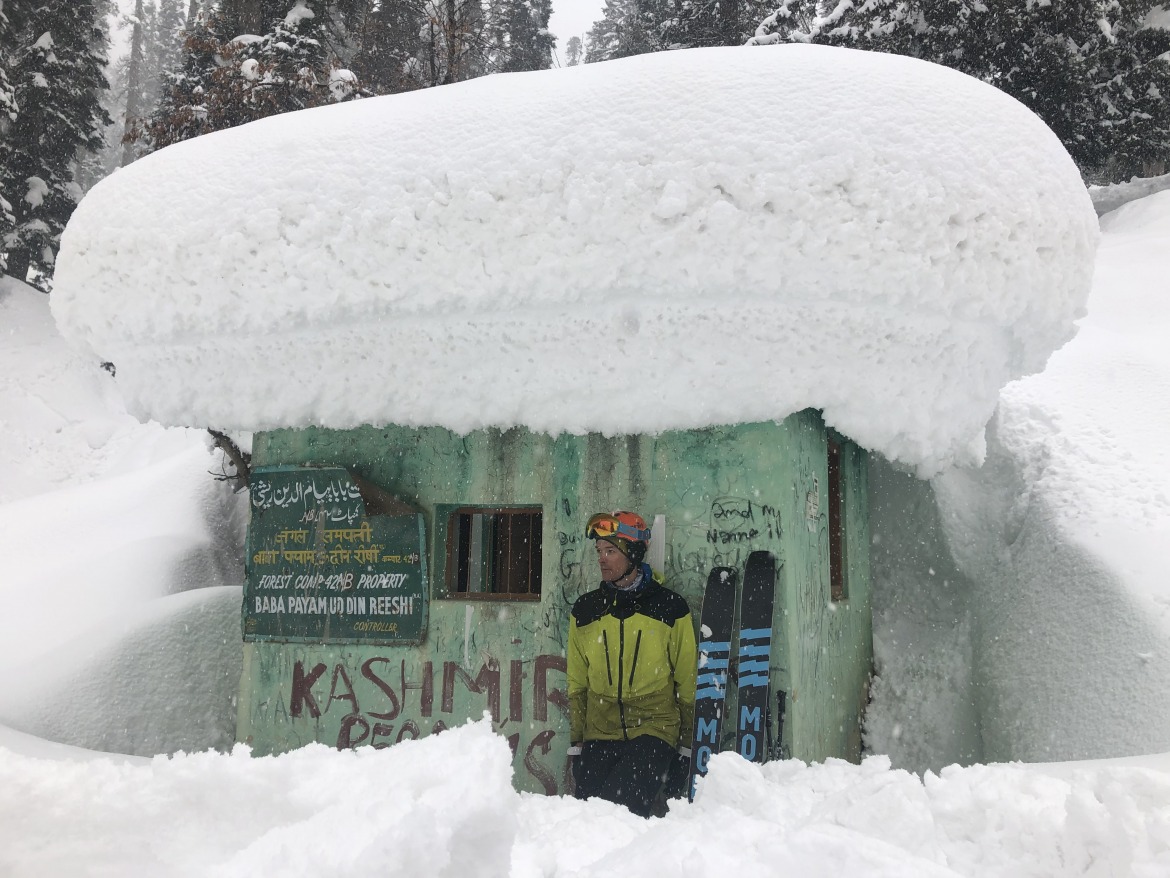
During large storm cycles in the Kashmir Himalaya, you ski the old growth cedar forests. Typical storms in Kashmir, called Western Disturbances, deposit 3-7 feet of snow over 24 – 48 hour periods. When the skies go blue again, it’s go time in some of the biggest Alpine ski terrain on the planet. In this image, Smithwick is catching a breather between powder laps in the forests of Baba Reshi, Baramulla, Kashmir. The forests are home to the Kashmir leopard and to snow monkeys, while the snow leopard lives in the alpine terrain above the forest.
WS: Let’s pivot to forecasting for a moment. Specifically, there’s no full-on avalanche forecasting where you travel and ski. Not at least how I imagine it here in North America. What might forecasting look like for you as you head out on an expedition? Are you simply aware of the general weather trends and then assessing on the ground?
LS:That’s the trick with Himalayan weather if we can go off on a tangent for a second. From say, 7500 meters up, you can forecast pretty well there. Whereas below that elevation, there’s so much orographic effect that it’s tough to forecast the weather – like when it will arrive and what to expect.
For example, I’m in Denver right now. And if you have an air mass that comes and hits the Rockies, it tends to go over the Rockies, but it’s pretty small. The Rockies are just this range that’s like 50 miles across; it’s not a lot. But the Karakoram and the Himalayas go on and on, and they jut into the atmosphere. It’s tough to forecast weather below 7500 meters accurately. So that’s one consideration, the poor weather forecasting below 7500 meters.
For example, the University of Utah models for specific canyons; they can model for Little Cottonwood or Big Cottonwood and for distinctive land formations, how it’s shaped, and how an air mass flows into them. They can forecast quite well, probably some of the best in the country. In contrast, things are a bit more generalized in other areas in North America and even more so in the Himalayas.
So there’s the complex weather factor. And then there’s the snow. When I come into an area, I get a baseline on north aspects, and I get a baseline on south aspects, which means I go out on day one, tour out into inconsequential terrain and get a complete pit profile. I see what’s going on with the stratigraphy in the snowpack. And then I take that, and I start to poke around and see what’s going on once again. You know, what is happening in low-consequence terrain, low slope angles, supported slopes, and figured out from there. It’s forecasting as I go. But that’s my background. I was in Kashmir for a time, working for the state of Kashmir as a forecaster. That’s where I spent most of my time learning forecasting in the Himalayas. Before that, I was in the Chugach for ten years, working for the Forest Service as a forecaster.
WS: You seem like you have this graceful balance between allowing you to make a living abroad in a stout range that we often associate with alpinism or high-altitude mountaineering, but you’re looking at it a lot of the time through a ski lens perspective. You are also pursuing your own goals. So I’m just curious, like pulling the lens out to the 10,000-foot view, how do you perceive yourself as someone who’s adventuring and guiding?
LS:I think I’m just really curious. If you look at my computer or phone, I have so many lists, multiple lists of things. And I get pulled in so many directions in the Himalayas. I love skiing. But it’s like a vehicle for me. It’s like you take the fishing rod because it gets you to the river. I think there’s more going on than just trying to catch a fish.
With my anthropology background, I’m interested in the languages and socio-economic change. If I’m out on an expedition, I’m not locked away in my tent with a mask on, focusing on skiing a line. I’m out talking to the shepherds to learn why they use, for example, one word in northeastern Pakistan is the same as in southeastern Nepal. I want to know how that happens, how these trade networks occur, and how it has changed historically. If you are asking how I see myself as an adventurer-explorer, I see myself as a student.
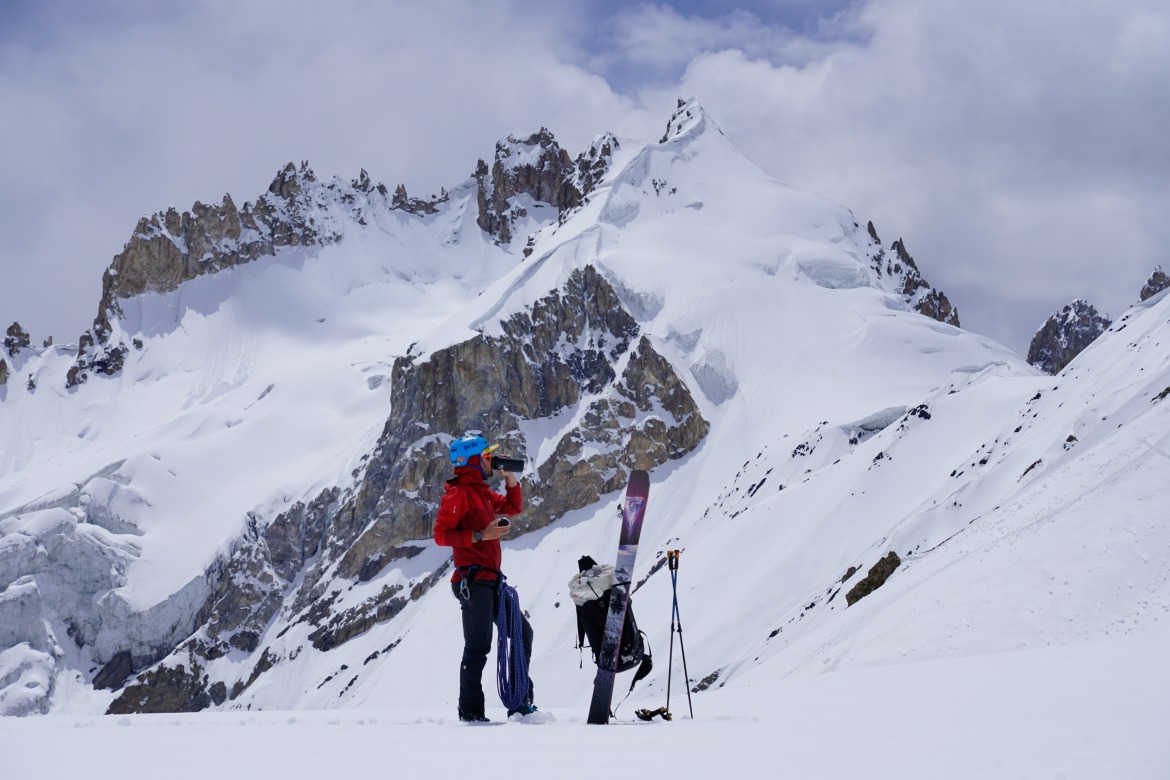
In between ski lines on the glaciated ski terrain of Shimshal, a lot of the Summer and Autumn skiing in the Himalaya and Karakoram is on glaciers, so you’ll need to bring glacier kit, the experience to use it, and be prepared for enjoying big steeper ski lines while in a base layer with a shell on. Smithwick spent 10 years living in Alaska, getting to know the Chugach and Alaska ranges well. It’s a pleasure to get to ski and explore in such massive terrain in mild temperatures at these lesser latitudes. The Himalaya are the same latitude as Florida.
WS: Wrapping my brain around the expanse of terrain in the Himalaya is overwhelming. From the outset of your HIMALAYA 500 odyssey to now, I’m curious about how you find lines to ski? Walk us through the process. Is it word of mouth? Just years eyeing lines? Google earth, AAJ reports?
LS:The process is multi-fold. I now get messages and emails from people from all over the world. They send me photos while they’re out in the Himalaya, and usually with a comment or a question. “Have you skied this yet?” “Check this one out!” “I wonder if this one goes!”
I absolutely love that. People are looking at the Himalaya now with the eyes of a skier, in places where historically it’s been expedition style mountaineering. It is nice to see that change and evolution, and also see others going out to try to ski in very wild places here.
In addition, yes I use the American Alpine Journal, as I think that’s a publication that most Americans are familiar with. But we also have to keep in mind the alpine journals in India, Nepal, Japan, UK, Austria, Germany, France and Slovenia. It’s a big world out there.
Google Earth is useful for getting a general visual of things. Yes. I use Gaia GPS for my planning.
Yes simply seeing things with my own eyes while I’m out on other projects is how I find some ski lines.
And then there are climbing movies, trekking movies, Youtube. There is so much media available these days. These are great resources for sorting out ski lines and doing general research on the Himalaya. Finally social media, that relatively new tool. I can scroll through and know the conditions across the Himalaya range in a few minutes (more or less).
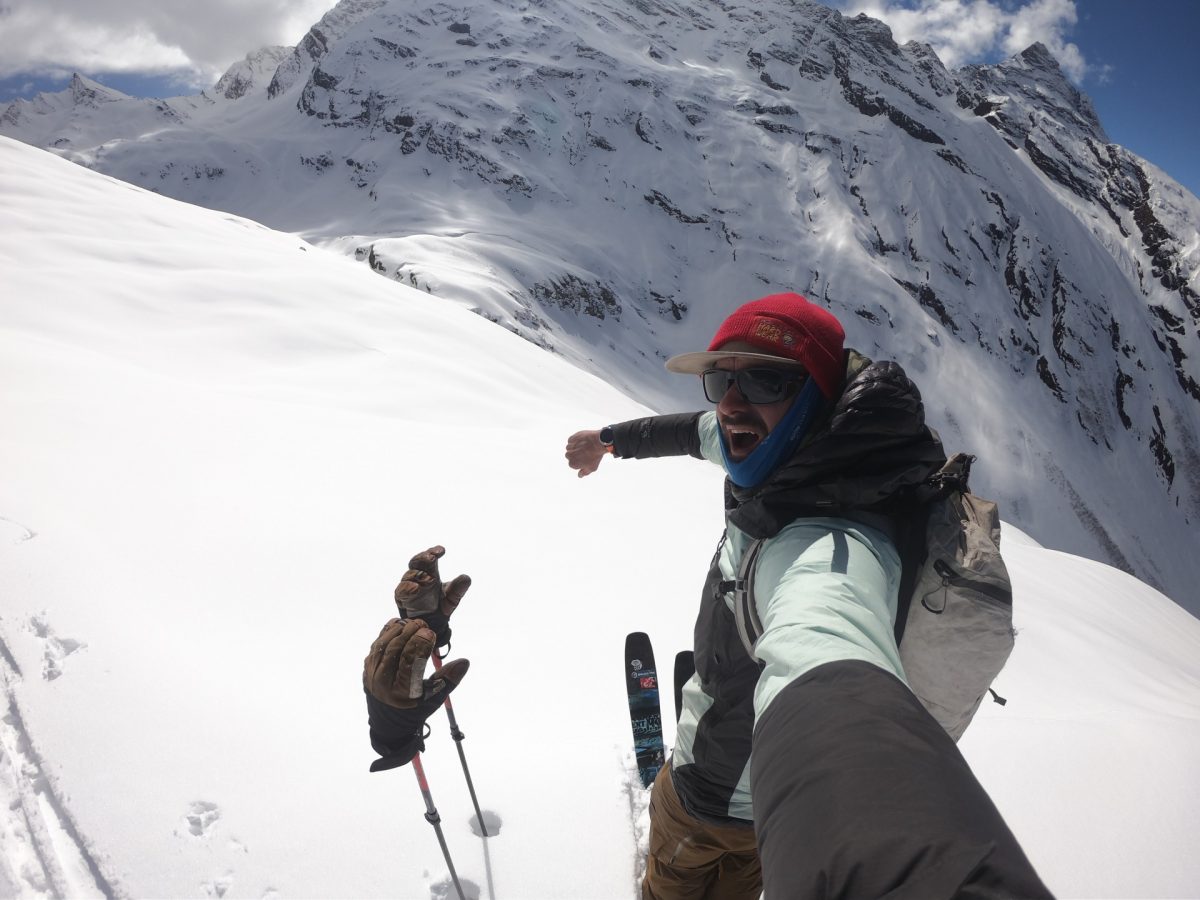
In far West Nepal, the Humla district catches the same storms as Kashmir. Up at 15,000 feet, looking around at the wild ski terrain available in the region. Smithwick will return to this area in March 2023 to ski more new lines. He knows it’s a destination for big mountain powder skiing.
WS: For someone wanting to explore the Himalayas for skiing, how might someone start envisioning a non-guided trip?
LS:It just takes so much. I would start with a resource like the American Alpine Journal, the AAJ. Yep, start with the AAJ, just search around, look at the pictures; there’s so much in all the photos. You might see a climber in the foreground, but what’s in the background? You start to look around. It’s all there. You have to put two and two together. I encourage people to get into the process and start figuring it out because it’s much more rewarding than having it handed to you. This is about my goal, inspiring people to go check out the Himalayas.
WS:Doing the rough math, I think you are in your 40s. How do you stay motivated for the life of a skiing nomad?
LS:Ha ha. I’ve never been called a “skiing nomad.” That’s a new one. It feels like I don’t have enough time in a given lifetime. I cannot get enough of skiing this mountain range. It’s simply the next level. I am excited about the future of skiing here.
On top of that, there is so much to learn and explore. That’s what really keeps me going is learning about the many layers of culture that are interwoven and ever evolving here. My background is cultural anthropology and environmental biology. When I’m in the mountains here there is never a dull moment. I’m looking for where the tracks lead to, then asking how to say certain words in a local dialect and comparing it to an adjacent valley, then discussing snowfall amounts with local shepherds. There’s simply too much and I cannot get enough of it.
You can learn more about Luke in this podcast episode of Mountain & Prairie — a solid podcast about life in the West if you are new to it.
And here’s a link to Smithwick’s resume for a complete look at his going up, and coming down.
Jason Albert comes to WildSnow from Bend, Oregon. After growing up on the East Coast, he migrated from Montana to Colorado and settled in Oregon. Simple pleasures are quiet and long days touring. His gray hair might stem from his first Grand Traverse in 2000 when rented leather boots and 210cm skis were not the speed weapons he had hoped for. Jason survived the transition from free-heel kool-aid drinker to faster and lighter (think AT), and safer, are better.
